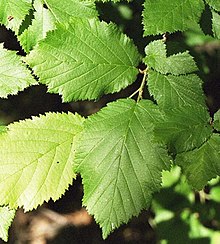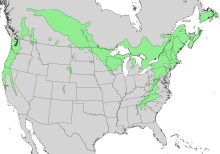Corylus cornuta
| Corylus cornuta | |
|---|---|

| |
| Beaked hazel foliage | |
| Scientific classification | |
| Kingdom: | Plantae |
| Clade: | Tracheophytes |
| Clade: | Angiosperms |
| Clade: | Eudicots |
| Clade: | Rosids |
| Order: | Fagales |
| Family: | Betulaceae |
| Genus: | Corylus |
| Species: | C. cornuta
|
| Binomial name | |
| Corylus cornuta | |

| |
| Natural range ofCorylus cornuta | |
| Synonyms[2] | |
|
List
| |
| Nutritional value per 100 g (3.5 oz) | |
|---|---|
| Energy | 2,629 kJ (628 kcal) |
22.98 g | |
| Dietary fiber | 9.8 g |
52.99 g | |
14.89 g | |
| Vitamins | Quantity %DV† |
| Thiamine (B1) | 40% 0.480 mg |
| Riboflavin (B2) | 12% 0.160 mg |
| Niacin (B3) | 20% 3.190 mg |
| Vitamin B6 | 32% 0.550 mg |
| Minerals | Quantity %DV† |
| Calcium | 34% 441 mg |
| Copper | 133% 1.200 mg |
| Iron | 17% 3.12 mg |
| Magnesium | 56% 235 mg |
| Manganese | 330% 7.600 mg |
| Phosphorus | 33% 411 mg |
| Potassium | 25% 738 mg |
| Sodium | 0% 2 mg |
| Zinc | 19% 2.06 mg |
| Other constituents | Quantity |
| Water | 5.92 g |
| †Percentages estimated usingUS recommendationsfor adults,[3]except for potassium, which is estimated based on expert recommendation fromthe National Academies.[4] | |
Corylus cornuta,thebeaked hazelnut(or justbeaked hazel), is adeciduousshrubbyhazelwith two subspecies found throughout most of North America.
Description[edit]
The beaked hazelnut can reach 4–8 metres (13–26 feet) tall with stems10–25 centimetres (4–9+3⁄4inches) thick with smooth gray bark,[5]but it can also remain relatively small in the shade of other plants. It typically grows with several trunks.
Theleavesare green, rounded oval with a pointed tip, coarsely double-toothed,5–11 cm (2–4+1⁄4in) long and3–8 cm (1+1⁄4–3+1⁄4in) broad, with soft and hairy undersides.
The male flowers arecatkinsthat form in autumn, pollinating the single female flowers the following spring to allow the fruits to mature through the summer.
The beaked hazelnut is named for its fruit, which is anutenclosed in a husk with a tubular extension2–4 cm (3⁄4–1+1⁄2in) long that resembles a beak. Tiny filaments protrude from the husk and may stick into, and irritate, skin that contacts them. The spherical nuts are small and surrounded by a hard shell. The beaked hazel is thehardiestof all hazel species, surviving temperatures of −50 °C (−58 °F) at its northern limits.[5]
It has a shallow and dense root system which is typically only 15 cm (6 in) deep, with a single taproot which may extend 0.6 m (2 ft) below the surface.[6]
Varieties[edit]
There are two varieties, divided by geography:[6]
- Corylus cornutavar.cornuta–Eastern beaked hazel.Small shrub, 4 to 6 m (13 to 20 ft) tall;[6]'beak' longer,3 cm (1+1⁄4in) or more. Occurs from 100–500 m (330–1,640 ft) throughout its range, and up to 1,000 m (3,300 ft) inAlberta.[6]
- Corylus cornutavar.californica–Western beaked hazelorCalifornia hazelnut.Large shrub, 4 to 15 m (13 to 49 ft) tall;[6]'beak' shorter, usually less than3 cm (1+1⁄4in). Occurs below 2,100 m (6,900 ft) inCalifornia,and below 800 m (2,600 ft) inBritish Columbia.TheConcow tribecalled this varietygōm’-he’’-ni(Konkow language).[7]California hazelnut is believed to be resistant toEastern filbert blight.[8]
Distribution and habitat[edit]
Eastern beaked hazel is found from southernCanadasouth toGeorgia,while the Western beaked hazel occurs along the west coast fromAlaskatoCalifornia.
Ecology[edit]
AlthoughC. cornutais somewhatshade tolerant,it is more common in forests with fairly open canopies than denser ones.[6]However, it is intolerant of entirely open areas that get hot and dry.[5]
Fire kills the above-ground portion of the shrub, but it resprouts fairly readily after fire from itsroot crownor rhizomes. It recovers after fire to the extent thatAmerican Indiansin California andOregonused fire to encourage its growth.[6]
In boreal regions, it is threatened by the invasiveSiberian peashrub,which can invade and achieve dominance in understories.[6]
Use by animals[edit]
Deer, moose, and livestock browse the foliage of the Eastern beaked hazel, but the Western beaked hazel is considered to have low palatability forungulates.[9]Thehazelnut weevilfeeds solely off the Western beaked hazel.[6]
American beaversprefer Eastern beaked hazel browse, and consume it to such an extent that they reduce its relative abundance in favor of conifers.[6]
The nuts ofC. cornuta californicaare an important food source for squirrels, especially as a backup in times ofacorncrop failure. Species such asDouglas squirrels,red squirrelsandleast chipmunksgather and stash the nuts, and although up to 66% of the nuts are consumed, the remainder have an elevated chance of germination due to being buried in soil or leaves. Although squirrels only distribute the nuts about 90 m (300 ft) or less,jayssuch as theblue jayin the east and theSteller's jayin the west distribute them over longer distances.Black bears,turkeys,andwhite-tailed deeralso consume the nuts.[6]
Ruffed grouseconsume the protein-rich catkins and young buds ofCorylus cornuta.[6]
It is used as cover by a variety of animal species, and provides good nesting for birds, especially the ruffed grouse. Thewhite-footed voleis positively correlated with California hazelnuts in theUmpqua National Forestin Oregon.[6]
Uses[edit]
Native Americans used the sprouts to create baskets, fish traps, and baby carriers. The nuts were eaten and commonly used as a trade good among indigenous groups—both theLewis and Clark expeditionand prolific early naturalistDavid Douglasbartered for beaked hazelnuts with local peoples they encountered. It was used medicinally asemetic,for deworming, as an astringent, and for teething.[6]
It is considered an excellent nut, with the same uses as any hazelnut.[10]While the beaked hazelnut does not produce as many nuts as commercial European species such as thecommon hazelorfilbert,it is more resistant to common diseases, and has been used in breeding programs to create high-yield, disease resistant hybrids.[6]
It is used inrestorationplantings to increase biodiversity, improve food sources for wildlife, and to reduce rates oflaminated root rotin nearbyDouglas-firandSitka spruce.[6]
Gallery[edit]
-
Male catkins
-
Female flowers
-
Leaves (and three fruits forming)
-
Immature fruit showing the "beak"
-
An immature nut with its hard shell
References[edit]
- ^Stritch, L.; Roy, S.; Shaw, K. & Wilson, B. (2020)."Corylus cornuta".IUCN Red List of Threatened Species.2020:e.T194448A174149241.Retrieved15 April2022.
- ^"Corylus cornutaMarshall ".Plants of the World Online.Board of Trustees of the Royal Botanic Gardens, Kew.Retrieved8 April2021.
- ^United States Food and Drug Administration(2024)."Daily Value on the Nutrition and Supplement Facts Labels".FDA.Archivedfrom the original on 2024-03-27.Retrieved2024-03-28.
- ^National Academies of Sciences, Engineering, and Medicine; Health and Medicine Division; Food and Nutrition Board; Committee to Review the Dietary Reference Intakes for Sodium and Potassium (2019). Oria, Maria; Harrison, Meghan; Stallings, Virginia A. (eds.).Dietary Reference Intakes for Sodium and Potassium.The National Academies Collection: Reports funded by National Institutes of Health. Washington, DC: National Academies Press (US).ISBN978-0-309-48834-1.PMID30844154.Archivedfrom the original on 2024-05-09.Retrieved2024-06-21.
- ^abc"Corylus cornuta"(PDF).Alberta Centre for Reclamation and Restoration Ecology.University of Alberta. Archived fromthe original(PDF)on 23 August 2016.Retrieved22 November2017.
- ^abcdefghijklmnopFryer, Janet L. (2007)."Corylus cornuta".Fire Effects Information System (FEIS).US Department of Agriculture (USDA), Forest Service (USFS), Rocky Mountain Research Station, Fire Sciences Laboratory.
- ^Chesnut, Victor King(1902).Plants used by the Indians of Mendocino County, California.Government Printing Office.p. 405.Retrieved24 August2012.
- ^Young-Mathews, Anna. September 2011. Plant fact sheet for California hazelnut (Corylus cornuta var. californica). USDA-Natural Resources Conservation Service, Corvallis Plant Materials Center, Corvallis, OR.https://plants.usda.gov/DocumentLibrary/factsheet/pdf/fs_cococ.pdf
- ^Whitney, Stephen (1985).Western Forests (The Audubon Society Nature Guides).New York: Knopf. p.428.ISBN0-394-73127-1.
- ^Nyerges, Christopher (2017).Foraging Washington: Finding, Identifying, and Preparing Edible Wild Foods.Guilford, CT: Falcon Guides.ISBN978-1-4930-2534-3.OCLC965922681.
External links[edit]
 Media related toCorylus cornutaat Wikimedia Commons
Media related toCorylus cornutaat Wikimedia Commons- Calflora
- Sawyer Jr., John O. (2012)."Corylus cornutasubsp.californica".In Jepson Flora Project (ed.).Jepson eFlora.The Jepson Herbarium,University of California, Berkeley.
- Corylus cornutain theCalPhotosphoto database,University of California, Berkeley







